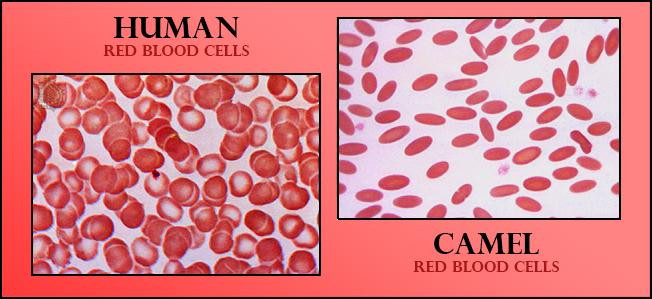
The RBCs of the camel are
A. Circular, convex and non-nucleated
B. Circular, convex and nucleated
C. Oval and non-nucleated
D. Oval and nucleated
Answer
575.1k+ views
Hint: The RBCs of camels are similar to the other mammals with the difference in the shape of the RBC, and the presence or absence of a nucleus.
Complete answer:
Like all mammals, camel's red blood cells do have the nucleus, that is they are nucleated and are oval instead of a round shape.
Additional Information:
-When the RBCs are developing in the red bone marrow, they do have nuclei. However, these nuclei are ejected from the cells when they enter the bloodstream in a process known as enucleation.
-In camels, the process of enucleation does not take place hence they have nucleated red blood cells.
-In camels, the erythrocytes or red blood cells are oval because the oval shape of the cell can circulate through thick blood and can expand during dehydration.
-The camel’s RBCs can be aligned in the various directions of the blood without any complications.
-The red blood cells of camels can expand to 240% of their initial size which as a result can hydrate their blood much more when allowed to drink water.
-In mammals, the RBC is generally binucleated, without the nucleus and the mitochondria.
-In mammals, the red blood cells do not contain any cell organelles making it rich in hemoglobin.
So, the correct answer is ‘Oval and nucleated’.

Note: Mammalian erythrocytes are typically biconcave discs shaped, flattened, and depressed in the center. This shape optimizes the flow properties of blood in the large vessels. However, there are certain exceptions concerning shape including cattle, deer; small and highly ovaloid cells in llamas and camels; tiny spherical cells in mice.
Complete answer:
Like all mammals, camel's red blood cells do have the nucleus, that is they are nucleated and are oval instead of a round shape.
Additional Information:
-When the RBCs are developing in the red bone marrow, they do have nuclei. However, these nuclei are ejected from the cells when they enter the bloodstream in a process known as enucleation.
-In camels, the process of enucleation does not take place hence they have nucleated red blood cells.
-In camels, the erythrocytes or red blood cells are oval because the oval shape of the cell can circulate through thick blood and can expand during dehydration.
-The camel’s RBCs can be aligned in the various directions of the blood without any complications.
-The red blood cells of camels can expand to 240% of their initial size which as a result can hydrate their blood much more when allowed to drink water.
-In mammals, the RBC is generally binucleated, without the nucleus and the mitochondria.
-In mammals, the red blood cells do not contain any cell organelles making it rich in hemoglobin.
So, the correct answer is ‘Oval and nucleated’.

Note: Mammalian erythrocytes are typically biconcave discs shaped, flattened, and depressed in the center. This shape optimizes the flow properties of blood in the large vessels. However, there are certain exceptions concerning shape including cattle, deer; small and highly ovaloid cells in llamas and camels; tiny spherical cells in mice.
Recently Updated Pages
Master Class 11 Chemistry: Engaging Questions & Answers for Success

Why are manures considered better than fertilizers class 11 biology CBSE

Find the coordinates of the midpoint of the line segment class 11 maths CBSE

Distinguish between static friction limiting friction class 11 physics CBSE

The Chairman of the constituent Assembly was A Jawaharlal class 11 social science CBSE

The first National Commission on Labour NCL submitted class 11 social science CBSE

Trending doubts
What is meant by exothermic and endothermic reactions class 11 chemistry CBSE

10 examples of friction in our daily life

One Metric ton is equal to kg A 10000 B 1000 C 100 class 11 physics CBSE

Difference Between Prokaryotic Cells and Eukaryotic Cells

What are Quantum numbers Explain the quantum number class 11 chemistry CBSE

1 Quintal is equal to a 110 kg b 10 kg c 100kg d 1000 class 11 physics CBSE




